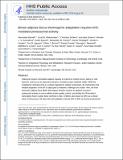Brown adipose tissue thermogenic adaptation requires Nrf1-mediated proteasomal activity
Author(s)
Bartelt, Alexander; Widenmaier, Scott B.; Schlein, Christian; Johann, Kornelia; Goncalves, Renata L. S.; Eguchi, Kosei; Fischer, Alexander W.; Parlakgul, Gunes; Snyder, Nicole A.; Nguyen, Truc B.; Bruns, Oliver Thomas; Franke, Daniel; Bawendi, Moungi G; Lynes, Matthew D.; Leiria, Luiz O.; Tseng, Yu-Hua; Inouye, Karen E.; Arruda, Ana Paula; Hotamisligil, Gokhan S.; ... Show more Show less
DownloadAccepted version (1.291Mb)
Terms of use
Metadata
Show full item recordAbstract
Adipocytes possess remarkable adaptive capacity to respond to nutrient excess, fasting or cold exposure, and they are thus an important cell type for the maintenance of proper metabolic health. Although the endoplasmic reticulum (ER) is a critical organelle for cellular homeostasis, the mechanisms that mediate adaptation of the ER to metabolic challenges in adipocytes are unclear. Here we show that brown adipose tissue (BAT) thermogenic function requires an adaptive increase in proteasomal activity to secure cellular protein quality control, and we identify the ER-localized transcription factor nuclear factor erythroid 2-like 1 (Nfe2l1, also known as Nrf1) as a critical driver of this process. We show that cold adaptation induces Nrf1 in BAT to increase proteasomal activity and that this is crucial for maintaining ER homeostasis and cellular integrity, specifically when the cells are in a state of high thermogenic activity. In mice, under thermogenic conditions, brown-adipocyte-specific deletion of Nfe2l1 (Nrf1) resulted in ER stress, tissue inflammation, markedly diminished mitochondrial function and whitening of the BAT. In mouse models of both genetic and dietary obesity, stimulation of proteasomal activity by exogenously expressing Nrf1 or by treatment with the proteasome activator PA28α in BAT resulted in improved insulin sensitivity. In conclusion, Nrf1 emerges as a novel guardian of brown adipocyte function, providing increased proteometabolic quality control for adapting to cold or to obesity. Subjects: Energy metabolism; Fat metabolism; Type 2 diabetes
Date issued
2018-03Department
Massachusetts Institute of Technology. Department of ChemistryJournal
Nature Medicine
Publisher
Springer Nature
Citation
Bartelt, A., Widenmaier, S., Schlein, C. et al. "Brown adipose tissue thermogenic adaptation requires Nrf1-mediated proteasomal activity." Nat Med 24, 292–303 (2018). © 2018 Nature America, Inc., part of Springer Nature.
Version: Author's final manuscript
ISSN
1546-170X
1078-8956